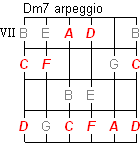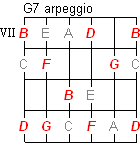
|
All the jazz education books and resources explain the ii-V-I progression early on, and working with this pattern was my first experience of actual jazz improvisation. It's a good place to start. This is a closer look at just three of the seven chords that emerge through harmonizing the major scale.
(Note that I'm now writing ii in lower case roman numerals, this is a convention to denote a minor chord) The ii-V-I progression is the most common chord progression in jazz. I'll explain the reason for that later, for now let's just take it as a given that this progression occurs repeatedly in hundreds of jazz tunes and standards. That makes it an excellent choice for isolating and working on improvising over, because you can use what you learn in all those tunes. The first step is to play the progression and hear the sound. Here are three ways to play it:
Note that I'm not keeping slavishly to Dm7 G7 Cmaj7 - this is jazz! Dm9 and Dm11 are two valid substitutes for Dm7, Cmaj7 and C69 are interchangeable, and G13 and G7#5 are just two of the many ways to play a G7. Let your creative spirit guide you, and use your ears. Play one four-beat measure each of Dm7 and G7, then two measures of Cmaj7. A good rhythm to use here is a steady four-to-the-bar, downstrokes only, played with a pick and muting the unused strings with your left hand fingers. Now to soloing. Remember these are all chords from the key of C, so the C major scale is going to be a good basis for improvising over the whole progression - maybe unexciting and vanilla, but free of "wrong" notes and a good place to start. The important point here is this: having identified all these chords as belonging to the key of C as described in the section on harmonizing the major scale, that tells us we can make life easy for ourselves by using a single C major fingering to improvise over the whole passage. Here's a standard C major fingering in the 7th fret position, shown with the chord tones highlighted for each of the three chords we're looking at:
Begin by concentrating on just the chord tones - within this fingering, play the 4 tones of each chord as the chords go by (the arpeggios), and try to improvise with these. Then try adding the other scale tones, but always remembering to emphasize the right chord tones in the right places - the same C major scale fingering is used throughout, but the chords are changing and your solo should reflect that. Emphasizing doesn't necessarily mean playing those tones louder, it means placing them on the strong beats and making them the last tone in your phrases. If you get it right, the sound of the chord progression should be clear in your solo even without any accompaniment. A final caveat: Although this is a great exercise to get you going, you shouldn't let yourself get too deeply into developing generic ii-V-I lines that you can use in all tunes. As you progress, you should pay attention to capturing the feel of each tune for itself. Why ii-V-I? To the human ear (or at least to the human ear brought up on the sound of western music), the resolution down a perfect 5th has a satisfyingly final, coming-to-rest feel. What you hear is the B in G7, which has an unsettling sound in the key of C, coming home by resolving up a half-tone to C; you hear the F in G7, which sounds very edgy in the key of C, resolving down a half-step to E, which is the maj 3rd of C and sounds just right; and you hear the G persisting through from G7 to C, anchoring the whole thing. To summarize, you hear something nearly-but-not-quite-right, moving in a small step to something just right, and that feels emotionally satisfying. This is not just a jazz thing: the G7 to C major resolution is referred to by music scholars as the authentic cadence, and it occurs throughout classical, pop, rock, blues and folk music. Anybody who's done some campfire strumming will have encountered this countless times in different keys: G7 to C, A7 to D, E7 to A, D7 to G, etc. Jazz adds the ii chord in front. From the ii to the V is also down a perfect 5th, so this extends and enhances the satisfying resolution effect. |
||||||||||||||||||||||||||||










